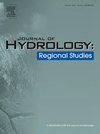Effects of rainfall runoff on photothermal environment in a large and deep drinking water reservoir
IF 5
2区 地球科学
Q1 WATER RESOURCES
引用次数: 0
Abstract
Study region
The Lake Qiandaohu basin, China.
Study focus
The photothermal environment is crucial for water ecological processes in deep reservoirs, as it is affected by hydrometeorological catchment processes. However, our knowledge remains limited regarding the response of the photothermal environment to different rainfall runoff intensities and changing hydrological processes due to the randomness of hydrometeorological processes. To address this, we collected photothermal environment data from three representative zones of Lake Qiandaohu between 2018 and 2019, analyzing the mechanisms by which rainfall runoff modulates this environment.
New hydrological insights for the region
The impact of rainfall runoff on the photothermal environment was influenced by the rainfall intensity and topographic location. Water column mixing occurred in the riverine zone when reservoir inflow exceeded 500 m3/s. As rainfall runoff intensity increased, the intrusion of interflow after extreme rainfall events increased the mid-layer water temperature in the transitional zone, forming a double thermocline structure. Moderate, strong, and extreme rainfall runoff substantially reduced the euphotic depth in the riverine zone by increasing the concentrations of optically active substance. The total suspended solids and chlorophyll-a were the primary factors influencing euphotic depth reductions in riverine and transitional zones, respectively (R²=0.64 and 0.45). Rainfall runoff primarily influenced the underwater photothermal environment through pulsed disturbances of the vertical temperature distribution and elevating the concentrations of optically active substances. The effects of rainfall runoff on the photothermal environment should be quantified to ensure the safety of drinking water in reservoirs.
大深水库降雨径流对光热环境的影响
研究区域:中国千岛湖盆地。研究重点光热环境是深层水库水生态过程的关键,因为它受水文气象集水过程的影响。然而,由于水文气象过程的随机性,关于光热环境对不同降雨径流强度和变化的水文过程的响应,我们的知识仍然有限。为了解决这一问题,我们收集了2018 - 2019年千岛湖三个代表性区域的光热环境数据,分析了降雨径流调节这一环境的机制。降雨径流对光热环境的影响受降雨强度和地形位置的影响。当入库流量超过500 m3/s时,河带发生水柱混合。随着降雨径流强度的增加,极端降雨事件后互流的侵入使过渡带中层水温升高,形成双温跃层结构。中等、强烈和极端降雨径流通过增加光活性物质的浓度,大大降低了河带的光深度。总悬浮物和叶绿素-a分别是影响河流和过渡带绿光深度减少的主要因素(R²=0.64和0.45)。降雨径流主要通过脉冲扰动温度垂直分布和提高光活性物质浓度来影响水下光热环境。为了保证水库饮用水的安全,应量化降雨径流对光热环境的影响。
本文章由计算机程序翻译,如有差异,请以英文原文为准。
求助全文
约1分钟内获得全文
求助全文
来源期刊

Journal of Hydrology-Regional Studies
Earth and Planetary Sciences-Earth and Planetary Sciences (miscellaneous)
CiteScore
6.70
自引率
8.50%
发文量
284
审稿时长
60 days
期刊介绍:
Journal of Hydrology: Regional Studies publishes original research papers enhancing the science of hydrology and aiming at region-specific problems, past and future conditions, analysis, review and solutions. The journal particularly welcomes research papers that deliver new insights into region-specific hydrological processes and responses to changing conditions, as well as contributions that incorporate interdisciplinarity and translational science.
 求助内容:
求助内容: 应助结果提醒方式:
应助结果提醒方式:


